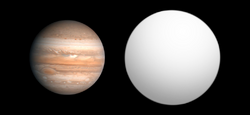Astronomy:HAT-P-4b
 Size comparison of HAT-P-4b with Jupiter. | |
| Discovery | |
|---|---|
| Discovered by | Kovacs et al. |
| Discovery site | Massachusetts , |
| Discovery date | Oct 2, 2007 |
| transit | |
| Orbital characteristics | |
| 0.04449+0.00083 −0.0012 AU | |
| Eccentricity | <0.0073[1] |
| Orbital period | 3.0565254±0.0000012[2] d |
| Inclination | 89.9 +0.1−2.2 |
| Semi-amplitude | 78.6+2.4 −2.3[1] |
| Star | HAT-P-4 |
| Physical characteristics | |
| Mean radius | 1.28+0.016−0.015 |♃|J}}}}}}[3] |
| Mass | 0.651+0.033 −0.037[1] |♃|J}}}}}} |
| Mean density | 410 ± 60 kg/m3 (690 ± 100 lb/cu yd) |
| 10.5 m/s2 (34 ft/s2) | |
HAT-P-4b is a confirmed extrasolar planet orbiting the star HAT-P-4 over 1000 light years away in Boötes constellation. It was discovered by transit on October 2, 2007, which looks for slight dimming of stars caused by planets that passed in front of them. It is the fourth planet discovered by the HATNet Project.[4] It is also called BD+36 2593b, TYC 2569-01599-1b, 2MASS J15195792+3613467b, SAO 64638b.
It is a hot Jupiter with 68% the mass and 127% the radius of Jupiter, and 41% the density of water (31% of Jupiter). Since the inclination is known by transit observation, the true mass is known. The secondary eclipse where the planet passes behind the star was detected by the Spitzer Space Telescope leading to the discovery that the planet has inefficient heat transfer from its day to night side.[5]
The study in 2012, utilizing a Rossiter–McLaughlin effect, have determined the planetary orbit is probably aligned with the rotational axis of the star, misalignment equal to -4.9±11.9°.[6]
References
- ↑ 1.0 1.1 1.2 Bonomo, A. S. et al. (2017). "The GAPS Programme with HARPS-N at TNG . XIV. Investigating giant planet migration history via improved eccentricity and mass determination for 231 transiting planets". Astronomy and Astrophysics 602: A107. doi:10.1051/0004-6361/201629882. Bibcode: 2017A&A...602A.107B.
- ↑ Sada, Pedro V. et al. (2012). "Extrasolar Planet Transits Observed at Kitt Peak National Observatory". Publications of the Astronomical Society of the Pacific 124 (913): 212–229. doi:10.1086/665043. Bibcode: 2012PASP..124..212S.
- ↑ Wang, Xian-Yu et al. (1 July 2021). "Transiting Exoplanet Monitoring Project (TEMP). VI. The Homogeneous Refinement of System Parameters for 39 Transiting Hot Jupiters with 127 New Light Curves". The Astrophysical Journal Supplement Series 255 (1): 15. doi:10.3847/1538-4365/ac0835. Bibcode: 2021ApJS..255...15W.
- ↑ Kovács, G. et al. (2007). "HAT-P-4b: A Metal-rich Low-Density Transiting Hot Jupiter". The Astrophysical Journal Letters 670 (1): L41–L44. doi:10.1086/524058. Bibcode: 2007ApJ...670L..41K.
- ↑ Todorov, Kamen O. et al. (2013). "Warm Spitzer Photometry of Three Hot Jupiters: HAT-P-3b, HAT-P-4b and HAT-P-12b". The Astrophysical Journal 770 (2): 102. doi:10.1088/0004-637X/770/2/102. Bibcode: 2013ApJ...770..102T.
- ↑ Albrecht, Simon; Winn, Joshua N.; Johnson, John A.; Howard, Andrew W.; Marcy, Geoffrey W.; Butler, R. Paul; Arriagada, Pamela; Crane, Jeffrey D. et al. (2012), "Obliquities of Hot Jupiter Host Stars: Evidence for Tidal Interactions and Primordial Misalignments", The Astrophysical Journal 757 (1): 18, doi:10.1088/0004-637X/757/1/18, Bibcode: 2012ApJ...757...18A
External links
Coordinates: ![]() 15h 19m 58s, +36° 13′ 47″
15h 19m 58s, +36° 13′ 47″
 |

